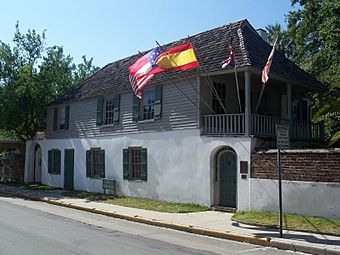St. Augustine Town Plan Historic District facts for kids
|
St Augustine Town Plan Historic District
|
|

Gonzalez-Alvarez House, an NHL itself and contributing property to the district
|
|
| Location | Roughly bounded by Grove Ave, the Matanzas River, and South and Washington Sts., St. Augustine, Florida |
|---|---|
| Area | 113 acres (46 ha) |
| NRHP reference No. | 70000847 |
Quick facts for kids Significant dates |
|
| Added to NRHP | April 15, 1970 |
| Designated NHLD | April 15, 1970 |
The St Augustine Town Plan Historic District is a special area in St. Augustine, Florida. It's like a time capsule that shows how the city was planned long ago. This district is a National Historic Landmark District, which means it's a very important historical place in the United States.
It includes the old street layout of St. Augustine. This plan was set up when the city was surrounded by walls. These walls were built between the 1500s and early 1800s, but they are not there anymore. The district is located near Cordova, Orange, and St. Francis Streets, and Matanzas Bay. It became a National Historic Landmark in 1970.
Contents
St. Augustine's Early History
How St. Augustine Was Founded
St. Augustine was started by Spain in 1565. This makes it the oldest place in mainland North America where Europeans settled permanently. It's north of Mexico. The city has a very long history of being a colony. This period lasted until 1822. That's when Spanish East Florida became part of the United States. It was then called the Florida Territory.
The City's Unique Street Plan
The main part of St. Augustine still has its original narrow streets. This street plan dates back to when Spain first controlled Florida. That first Spanish period ended in 1763. At that time, Florida was given to Great Britain. However, Britain gave Florida back to Spain in 1784. About half of the buildings in this historic area were built before 1925. Many of them show Spanish Colonial or Moorish Revival building styles.
Important Landmarks to See
Famous Buildings and Sites
Some of St. Augustine's most famous landmarks are found in this district. Many of these important places started during the Spanish settlement.
Castillo de San Marcos
The Castillo de San Marcos is a large fort at the northeast end of the district. Its construction began when the community was founded. It was built to protect the city.
The Central Plaza
The central plaza was also an early and important part of the city. Today, the Cathedral Basilica of St. Augustine faces this plaza. This church was built between 1793 and 1794, during the second Spanish period. A post office from the 1930s also faces the plaza. It was designed to look very much like the original Spanish governor's palace that it replaced.
Oldest Homes in the City
Further south in the district, you can find some of the city's oldest homes that are still standing. These include the González–Alvarez House, built around 1723. It's also known as the Oldest House in the city. Another old home is the Llambias House.
Other Historic Buildings
Many other important buildings are part of this historic district. They help tell the story of St. Augustine's past. Here are some of them:
- Benet Store
- Blacksmith Shop
- Florida Heritage House (Wakeman House)
- Gallegos House
- Gómez House
- Gonzáles and De Hita Houses
- Luciano de Herrera House
- Oliveros House
- Pellicer-De Burgo House
- Ponce de Leon Hotel
- Ribera House
- Rodríguez House
- Salcedo House & Kitchen
- Santoyo House
- Sims Silversmith Shop
- Spanish Military Hospital Museum
- Triay House
- Wells Print Shop
- William Watson House
Images for kids








